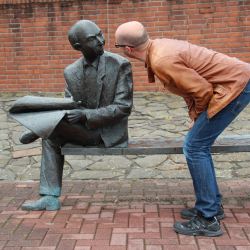Statues, memorials, and street names all commemorate our chosen cultural history. Street names, in particular, because their cost is less than a commissioned statue or memorial, making renaming easier may “mirror a city’s social, cultural, political, and even religious values.” New research on “streetonomics” may provide insight.
The researchers, reporting in PLOS One, set out looking at “honorific” street names – when a street maintains its positional name, like 161st Street and River Avenue, and gains another name, Mariano Rivera Avenue, in their honor. (NY City has 1648 honorific streets)
As the researchers point out, street naming is linked to power and shapes the message that power wants to share. Much of the fighting over Confederate monuments is about the messaging, not the individual. (Listen to this podcast for a great exposition on that topic.) The researchers considered four large cities, Paris, Vienna, London, and New York. They categorized the street names based upon gender, whether the names were from the recent or distant past, whether the individuals were locals or globals, and what professions they reflected – a reasonable first approximation of some of our cultural signposts.
"For centuries, women were relegated to the private sphere, while men dominated the public sphere. Urban planning was no exception; cities were built by men and for men—and that made street naming gender-biased."
- 4% of streets in Paris
- 5% for Vienna, down from a high of 10%
- 40% for London
- 26% in New York, predominantly in Manhattan
Does our culture celebrate our past, or does it look more to our future, honoring those of more recent memory?
- Paris celebrates the 1860’s when Paris was transformed into its more modern-day urbanicity.
- Vienna reflects the 1900’s after World War I, which destroyed the city, necessitating its rebuilding, and before the Nazi invasion of Austria.
- London too celebrates its rebuilding, but that dates back to the Great Fire of London in 1666 and involves historical figures from the 18th and early 19th centuries.
- New York celebrates individuals from the 1950s to now. It is not surprising that a little over a third are victims and responders to the destruction of the Twin Trade Towers on 9/11
“Societies characterized by higher levels of power distance are more inclined to build highly hierarchical social structures and to celebrate high-status individuals—for example, those who have elite professions. The occupation might also contain information about the types of achievements that are most celebrated … individualistic societies value more personal achievements rather than collective achievements.”
- Paris honors the military after World War II; its spiritual rebirth was from artists, writers, and scientists, all of whom displaced the military over time.
- Vienna also celebrates its artists, although, like Paris, the military had its moment. Writers and scientists took a “back seat” to legal and social occupations.
- London celebrates the Royals, its politicians, and military leaders
- New York celebrates the “great middle,” members of business and community. Again, the large number of honorific street names connected with 9/11 play an outsize role here.
How cosmopolitan, how global a world view is reflected in our naming choices?
- Vienna has the greatest number of streets named for foreigners, 44.6%. The naming peaked with the establishment of the Austria-Hungarian republic and has now dropped to 18% of recent namings.
- London follows at 14.6%. More local personages were celebrated after the World Wars; more international choices were made as London assumed its renewed role as a financial and cultural center.
- Paris has 10.9%. There was a higher peak at 18% shortly after the French Revolution, but that proportion dropped to the current levels almost a century ago.
- New York, the most insular of all these international cities, had streets named for foreigners in 3.2% of cases. While New York is a global financial center, it is younger and does not have the same cultural history as the other three cities.
Street names can and do reflect our cultural treasures, although it is clear that what we treasure is subject to bias, as in the case of streets named for women, and can vary with time, as the rise and fall of military figures suggest. They also reflect the length of our history as well as our perceived role in the world.
We cannot generalize to all cities and cultures. There is no information on large Asian, Middle Eastern, African, or South American cities. That said, it does provide an interesting window into how the powerful in our society wishes to represent our culture in our day-to-day lives and to the rest of the world.
Source: Streetonomics: Quantifying culture using street names, PLOS One DOI: 10.1371/journal. pone.0252869

